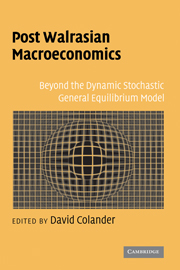Book contents
- Frontmatter
- Contents
- List of Contributors
- Foreword by Alan Kirman
- Introduction
- PART I WHERE WE ARE IN MACRO AND HOW WE GOT THERE
- PART II EDGING AWAY FROM THE DSGE MODEL
- PART III LEAPING AWAY FROM THE DSGE MODEL
- PART IV LETTING THE DATA GUIDE THEORY
- 12 The Past as the Future: The Marshallian Approach to Post Walrasian Econometrics
- 13 Old World Econometrics and New World Theory
- 14 Four Entrenched Notions Post Walrasians Should Avoid
- 15 Confronting the Economic Model with the Data
- 16 Extracting Information from the Data: A European View on Empirical Macro
- PART V POLICY IMPLICATIONS
- Bibliography
- Index
12 - The Past as the Future: The Marshallian Approach to Post Walrasian Econometrics
Published online by Cambridge University Press: 02 December 2009
- Frontmatter
- Contents
- List of Contributors
- Foreword by Alan Kirman
- Introduction
- PART I WHERE WE ARE IN MACRO AND HOW WE GOT THERE
- PART II EDGING AWAY FROM THE DSGE MODEL
- PART III LEAPING AWAY FROM THE DSGE MODEL
- PART IV LETTING THE DATA GUIDE THEORY
- 12 The Past as the Future: The Marshallian Approach to Post Walrasian Econometrics
- 13 Old World Econometrics and New World Theory
- 14 Four Entrenched Notions Post Walrasians Should Avoid
- 15 Confronting the Economic Model with the Data
- 16 Extracting Information from the Data: A European View on Empirical Macro
- PART V POLICY IMPLICATIONS
- Bibliography
- Index
Summary
The popular image of the scientific revolution usually pits young revolutionaries against old conservatives. Freeman Dyson (2004, p. 16) observes that, in particle physics in the mid twentieth century, something had to change. But in the revolution of quantum electrodynamics, Einstein, Dirac, Heisenberg, Born, and Schödinger were old revolutionaries, while the winners, Feynman, Schwinger, and Tomonaga, were young conservatives. Post Walrasian economics is not a doctrine, but a slogan announcing that something has to change. Most of the self-conscious efforts to forge a Post Walrasian economics are due to old radicals. Here I want to explore the space of the young conservative: the future is past, particularly in the methodology of Alfred Marshall's essay, “The Present Position of Economics” (1885). The radical approach identifies the problem as Walrasian theory and seeks to replace it with something better and altogether different. The conservative approach says that theory is not the problem. The problem is rather to establish an empirical discipline that connects theory to the world.
Marshall's methodology places the relationship between theory and empirical tools on center stage. In North America, if not in Europe, the dominant tools of macroeconometrics are the vector autoregression (VAR) and calibration techniques. These techniques reached their current status as the result of two nearly simultaneous reactions to the Cowles Commission program, which dominated macroeconometrics during the two decades 1950–70. These are the famous Lucas critique, and the practically influential, if less storied, Sims critique.
- Type
- Chapter
- Information
- Post Walrasian MacroeconomicsBeyond the Dynamic Stochastic General Equilibrium Model, pp. 239 - 257Publisher: Cambridge University PressPrint publication year: 2006
- 26
- Cited by



